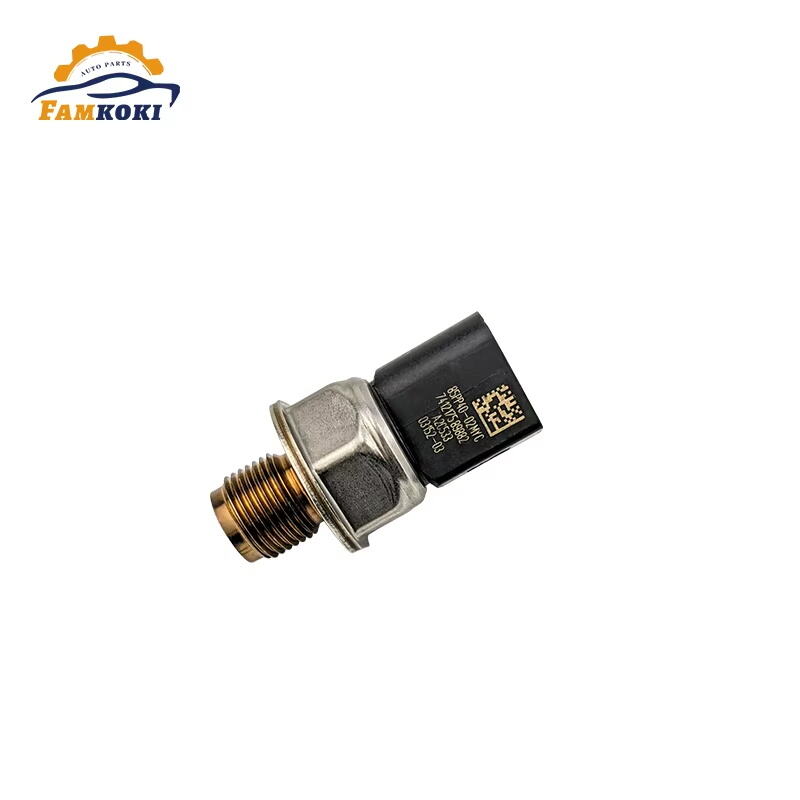Comprensión de los sensores de oxígeno
Los sensores de oxígeno son fundamentales para el rendimiento de un vehículo, ya que monitorean los niveles de oxígeno en los gases de escape. Al analizar estos datos, la unidad de control del motor (ECU) puede ajustar la mezcla de aire-combustible, optimizando así la eficiencia del combustible y reduciendo las emisiones. Estos sensores aseguran que el motor funcione correctamente y cumpla con las regulaciones ambientales al equilibrar el proceso de combustión. Un rendimiento confiable de los sensores de oxígeno puede prevenir un consumo innecesario de combustible y reducir la huella ecológica del vehículo.
Sin embargo, los sensores de oxígeno pueden experimentar degradación con el tiempo, generalmente evidente entre 60,000 y 100,000 millas. Este desgaste puede llevar a lecturas incorrectas, causando síntomas como una mala economía de combustible, funcionamiento irregular en punto muerto y la iluminación de la luz de control del motor. El mantenimiento regular y la observación atenta de estos indicadores puede ayudar a identificar cuándo es necesario un reemplazo. Abordar los problemas del sensor de oxígeno de manera oportuna puede prevenir problemas más graves en el motor, evitando reparaciones costosas y asegurando que el vehículo permanezca en óptimas condiciones de funcionamiento.
Herramientas y materiales necesarios para el reemplazo del sensor de oxígeno
Reemplazar un sensor de oxígeno requiere herramientas y materiales específicos para asegurar una instalación exitosa sin dañar el vehículo. Las herramientas esenciales incluyen un juego de llaves inglesas, una llave para sensor de oxígeno y un compuesto antiatascamiento. El juego de llaves inglesas ayuda a aflojar el sensor viejo y asegurar el nuevo. La llave para sensor de oxígeno está diseñada específicamente para ajustarse al sensor sin dañar su cableado, lo cual puede ser un factor crucial teniendo en cuenta los espacios confinados donde a menudo se encuentran estos sensores. El compuesto antiatascamiento, aplicado a los hilos del nuevo sensor, facilita su futura eliminación, evitando que se atasque debido a la óxido o la exposición al calor.
Al reemplazar un sensor de oxígeno, contar con los materiales adecuados es tan crucial como tener las herramientas correctas. Comience con un nuevo sensor de oxígeno compatible con su modelo de vehículo. La compatibilidad es fundamental para asegurar que el sensor funcione correctamente con la unidad de control del motor (ECU), manteniendo el equilibrio óptimo de aire-combustible y reduciendo las emisiones. Además, el compuesto antiatascamiento mencionado anteriormente es crucial para garantizar una mayor durabilidad y facilitar el mantenimiento futuro. Al usar el sensor correcto y aplicar los materiales necesarios, asegura el rendimiento óptimo y la durabilidad del sensor con el tiempo.
Guía Paso a Paso para la Instalación de un Sensor de Oxígeno por Tu Cuenta
Instalar correctamente un nuevo sensor de oxígeno por tu cuenta puede ser un proceso sencillo si sigues los pasos necesarios. Aquí tienes una guía completa para ayudarte a través de este proceso:
Paso 1: Ubica el/los Sensor(es) de Oxígeno
Comience consultando el manual de servicio de su vehículo, que proporciona ubicaciones precisas para los sensores de oxígeno. Estos a menudo se encuentran en el colector de escape o en la tubería aguas abajo. La mayoría de los vehículos tienen múltiples sensores, categorizados como aguas arriba (antes del catalizador) y aguas abajo (después del catalizador).
Paso 2: Desconectar el Conector Eléctrico
Garantice su seguridad apagando el vehículo y quitando las llaves del contacto para evitar cortocircuitos accidentales o descargas eléctricas. Desconecte el conector eléctrico adjunto al sensor presionando suavemente la pestaña de bloqueo y separando el conector.
Paso 3: Retire el Sensor Viejo Usando la Herramienta Adecuada
Utilice un llave inglesa y un socket para sensor de oxígeno para desatornillar el sensor existente. Si el sensor es difícil de quitar debido a la óxido o corrosión, aplique un penetrante para aflojar la conexión. Un consejo profesional es dejar que el penetrante actúe durante unos minutos para un aflojamiento efectivo.
Paso 4: Instale el Nuevo Sensor y Aplique Compuesto Antiatascador
Antes de la instalación, aplique una pequeña cantidad de compuesto antiatascante en los hilos del nuevo sensor. Esto previene que se atasque en el futuro y facilita su retirada. Rosque cuidadosamente el nuevo sensor a mano para evitar cruzar los hilos, luego ajuste según las especificaciones del fabricante utilizando un par de torsión.
Paso 5: Reconectar el Conector Eléctrico
Finalmente, vuelva a conectar el conector eléctrico de manera segura. Asegúrese de que no haya cables desgastados y que los conectores estén en buen estado. Esto ayudará a mantener una conexión confiable y una operación eficiente del sensor.
Al seguir estos pasos, puede asegurar un exitoso reemplazo de sensor de oxígeno DIY, contribuyendo a un mejor rendimiento del vehículo y eficiencia en el consumo de combustible. Como en todas las reparaciones automotrices, tome su tiempo y priorice la seguridad durante todo el proceso.
Consejos y precauciones para una instalación segura
Al trabajar en un vehículo, emplear las medidas de seguridad adecuadas es crucial para prevenir lesiones y asegurar una instalación exitosa. Siempre uses gafas de seguridad y guantes para protegerte de posibles peligros. Asegúrate de que el motor esté completamente frío antes de comenzar a trabajar para evitar quemaduras. Además, es vital trabajar en un espacio bien ventilado para reducir el riesgo de inhalar gases dañinos. Estas precauciones no solo garantizan tu bienestar, sino que también contribuyen a un proceso de instalación fluido y eficiente.
Los errores comunes durante la instalación de un sensor de oxígeno pueden llevar a problemas eléctricos futuros o daños. Un error crítico es olvidar desconectar la batería, lo que puede crear cortocircuitos eléctricos o riesgos de choque. Además, ajustar en exceso el sensor puede dañar los hilos, haciendo que futuras extracciones sean difíciles y potencialmente costosas. Por último, descuidar aplicar un compuesto antiatascamiento a los hilos del nuevo sensor puede causar complicaciones futuras, como que el sensor quede atascado. Ser consciente de estos errores comunes puede ayudar a garantizar una instalación y mantenimiento futuro sin problemas.
Conclusión
La instalación de un sensor de oxígeno es un componente crítico para mantener la eficiencia y el rendimiento del vehículo. Asegurar una instalación adecuada y segura implica una atención meticulosa a los detalles y el cumplimiento de los protocolos de seguridad. Recuerda usar el equipo de protección adecuado, como gafas de seguridad y guantes, y asegúrate de que el motor esté frío antes de comenzar el trabajo para evitar quemaduras. Trabaja en áreas bien ventiladas para evitar inhalar gases dañinos. Siempre desconecta la batería para prevenir problemas eléctricos, y ten cuidado de no apretar demasiado el sensor para evitar dañar los hilos. Al aplicar cuidadosamente compuesto antiatascamiento en los hilos, puedes prevenir futuros problemas al quitar el sensor. Seguir estos consejos y mantener la vigilancia durante el proceso de instalación ayudará a garantizar un funcionamiento más fluido y la longevidad del sistema del vehículo.
Preguntas frecuentes
P1: ¿Con qué frecuencia deben reemplazarse los sensores de oxígeno?
Típicamente, los sensores de oxígeno deben ser reemplazados cada 60,000 a 100,000 millas para asegurar el mejor rendimiento del vehículo y la eficiencia en el consumo de combustible.
P2: ¿Qué síntomas indican un sensor de oxígeno defectuoso?
Los síntomas de un sensor de oxígeno defectuoso incluyen una baja eficiencia en el consumo de combustible, funcionamiento irregular del motor en reposo, y la luz de control del motor encendiéndose en el tablero.
P3: ¿Por qué es importante aplicar un compuesto antiatascamiento en los hilos?
Aplicar un compuesto antiatascamiento previene que el sensor quede atrapado en el futuro debido a la óxidación o el calor, facilitando futuras extracciones.
P4: ¿Puede una instalación por cuenta propia afectar las garantías del vehículo?
Las instalaciones por cuenta propia pueden anular las garantías si no se realizan de acuerdo con las directrices del fabricante. Es recomendable revisar los términos de la garantía antes de proceder.
P5: ¿Es necesario desconectar la batería al reemplazar el sensor de oxígeno?
Sí, desconectar la batería es necesario para prevenir cortocircuitos eléctricos o riesgos de descarga durante el proceso de reemplazo.
 EN
EN
 AR
AR
 FR
FR
 KO
KO
 PT
PT
 RU
RU
 ES
ES


